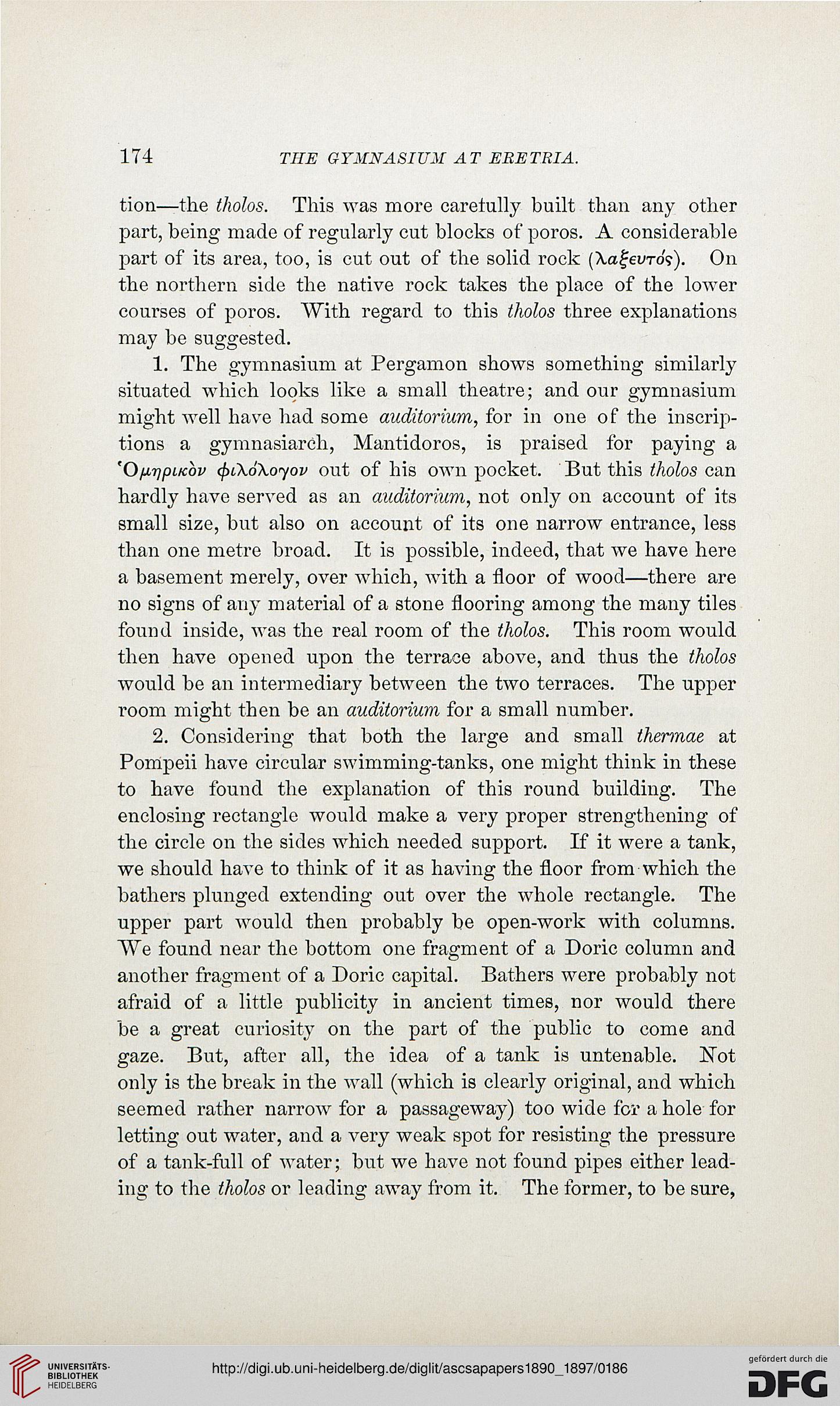174
THE GYMNASIUM AT EBETRIA.
tion—the tholos. This was more caretully built than any other
part, being made of regularly cut blocks of poros. A considerable
part of its area, too, is cut out of the solid rock (Xafeuro?). On
the northern side the native rock takes the place of the lower
courses of poros. With regard to this tholos three explanations
may be suggested.
1. The gymnasium at Pergamon shows something similarly
situated which looks like a small theatre; and our gymnasium
might well have had some auditorium, for in one of the inscrip-
tions a gymnasiarch, Mantidoros, is praised for paying a
'Ofi-qpiKov <f>i\6\oyov out of his own pocket. But this tholos can
hardly have served as an auditorium, not only on account of its
small size, but also on account of its one narrow entrance, less
than one metre broad. It is possible, indeed, that we have here
a basement merely, over which, with a floor of wood—there are
no signs of any material of a stone flooring among the many tiles
found inside, was the real room of the tholos. This room would
then have opened upon the terrace above, and thus the tholos
would be an intermediary between the two terraces. The upper
room might then be an auditorium for a small number.
2. Considering that both the large and small thermae at
Pompeii have circular swimming-tanks, one might think in these
to have found the explanation of this round building. The
enclosing rectangle would make a very proper strengthening of
the circle on the sides which needed support. If it were a tank,
we should have to think of it as having the floor from which the
bathers plunged extending out over the whole rectangle. The
upper part would then probably be open-work with columns.
We found near the bottom one fragment of a Doric column and
another fragment of a Doric capital. Bathers were probably not
afraid of a little publicity in ancient times, nor would there
be a great curiosity on the part of the public to come and
gaze. But, after all, the idea of a tank is untenable. Not
only is the break in the Avail (which is clearly original, and which
seemed rather narrow for a passageway) too wide foi' a hole for
letting out water, and a very weak spot for resisting the pressure
of a tank-full of water; but we have not found pipes either lead-
ing to the tholos or leading away from it. The former, to be sure,
THE GYMNASIUM AT EBETRIA.
tion—the tholos. This was more caretully built than any other
part, being made of regularly cut blocks of poros. A considerable
part of its area, too, is cut out of the solid rock (Xafeuro?). On
the northern side the native rock takes the place of the lower
courses of poros. With regard to this tholos three explanations
may be suggested.
1. The gymnasium at Pergamon shows something similarly
situated which looks like a small theatre; and our gymnasium
might well have had some auditorium, for in one of the inscrip-
tions a gymnasiarch, Mantidoros, is praised for paying a
'Ofi-qpiKov <f>i\6\oyov out of his own pocket. But this tholos can
hardly have served as an auditorium, not only on account of its
small size, but also on account of its one narrow entrance, less
than one metre broad. It is possible, indeed, that we have here
a basement merely, over which, with a floor of wood—there are
no signs of any material of a stone flooring among the many tiles
found inside, was the real room of the tholos. This room would
then have opened upon the terrace above, and thus the tholos
would be an intermediary between the two terraces. The upper
room might then be an auditorium for a small number.
2. Considering that both the large and small thermae at
Pompeii have circular swimming-tanks, one might think in these
to have found the explanation of this round building. The
enclosing rectangle would make a very proper strengthening of
the circle on the sides which needed support. If it were a tank,
we should have to think of it as having the floor from which the
bathers plunged extending out over the whole rectangle. The
upper part would then probably be open-work with columns.
We found near the bottom one fragment of a Doric column and
another fragment of a Doric capital. Bathers were probably not
afraid of a little publicity in ancient times, nor would there
be a great curiosity on the part of the public to come and
gaze. But, after all, the idea of a tank is untenable. Not
only is the break in the Avail (which is clearly original, and which
seemed rather narrow for a passageway) too wide foi' a hole for
letting out water, and a very weak spot for resisting the pressure
of a tank-full of water; but we have not found pipes either lead-
ing to the tholos or leading away from it. The former, to be sure,





